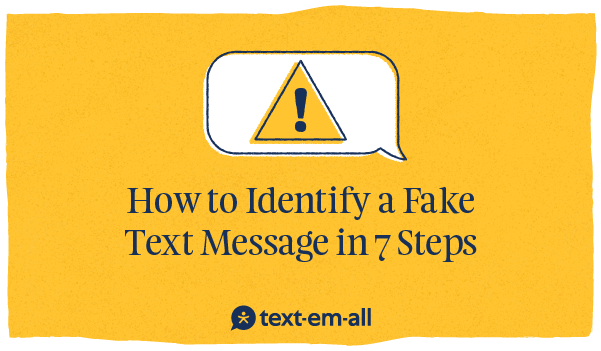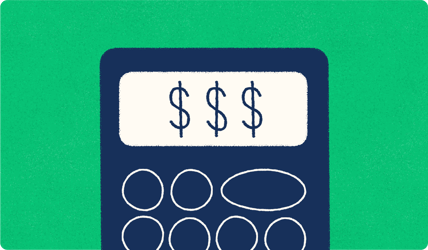
According to the Federal Trade Commission (FTC), consumer losses from text scams reached an all-time high in 2022. The FTC reports that US consumers lost $326 million to text scams, a 30% increase from 2021.
When you receive an unsolicited text message from the Internal Revenue Service, how do you tell if a scammer is texting you? Luckily, there is more than one way to spot a fake text message, and we've produced a simple guide on identifying them.
Table of Contents
How do Text Scams Target People?
How to Identify a Fake Text Message: 7 Signs
You've Identified a Text Message Scam - Now What?
How to Respond in Case of Doubt
How do I Make Sure I Send Safe Messages?
How Do Text Scams Target People?
Fake text messages are designed to fulfill one objective: To trick you into providing personal or account information. The information could be your Social Security Number, bank information, or email password, depending on the type of phony text. Once cybercrooks get hold of the information, they can access your accounts.
Fake text messages tend to revolve around the same strategies:
- They offer incredible financial support or random prizes.
- They warn about money-related problems, ranging from suspicious deliveries to unpaid invoices.
- They inform you about someone in a crisis - usually a family member.
- They often include a suspicious link.
If you receive an unexpected text message requiring personal details while promising or asking for money, this should immediately raise a red flag.
How to Identify a Fake Text Message: 7 Signs
Text scamming activates a sense of panic in the recipient, so people act before thinking. Before responding, look out for these seven signs.
1. The message isn't relevant to you
First, the message comes as an unexpected notification, not prompted by any interaction with a business or an individual. Popular text scams refer to a delivery problem with a parcel, an unpaid invoice, or a contest prize.
You can disregard the message when you ask yourself a few simple questions: Did I order something I’m waiting to be delivered? Did I participate in a competition? If the answer is no, it's most likely a fake text.
“Your order has arrived at our shipping facility, but we need you to confirm your information before we deliver your package.”
2. The message requires you to take immediate action
Text scams encourage you to act now. They request immediate action for one simple reason: You are less likely to consider your options if you feel pressured to react. No business or government agency would demand immediate action.
“Hi Taylor, this is your boss. I need something from you right now. Please text back as soon as you receive this, or else your job is in jeopardy.”
3. The message contains grammatical and spelling errors
Fake text messages often include awkward sentence structures. While this isn't always the case, it is a consistent signal you can quickly check.
Scam texts often include:
- Unusual spacing between characters
- Unfinished sentences
- Poor grammar
- Spelling mistakes
“Good news: Your a winner! Congradulations.! To claim you’re prize respond with YES.”
4. The message contains inaccurate statements
Fraudulent messages include statements you can easily verify.
If you receive a message from a contact in crisis who needs you to send money, you can easily verify the situation by calling the person or a mutual friend.
You can verify if there was suspicious activity in your bank account by logging into your online banking account from a secure source.
If a recognizable firm gets in touch with you, reach out to verify via their website. The most commonly masqueraded firms by fraudsters (Amazon, Costco, FedEx, and the IRS) do not initiate unsolicited contact by text to ask for sensitive information.
“Hi Sarah, this is Lea. My car broke down and I left my credit card at home. Can you Venmo me $200? I’m stranded!”
5. The number is unidentified
When a legitimate business sends a text message, its number is identified and recognized. Similarly, when a contact gets in touch, your phone should recognize their number, too. Text scamming typically uses 11-digit unidentified mobile numbers.
6. The text contains suspicious links
While some companies can send you a shortened link per text message, the URL shows the shortening service used, such as TinyURL or Bit.ly.
On the other hand, a suspicious link usually will NOT display any recognizable signs of using a URL shortening service despite showing a similar string of characters.
NEVER click on a suspicious link you receive through text. Clicking on the link may download malware to your device.
“To confirm your enrollment, click here: bil.ty/scam123”
7. The message uses incorrect branding
Scam text messages will sometimes mimic the names of legitimate companies in the message and URL. The link is slightly different from the one of the companies it pretends to come from:
- Misspelled domain names such as Ammazon.com instead of Amazon.com
- Added signs such as “.” or digits in the URL www1.royalbank.com rather than www.royalbank.com
- Unnatural subdomain
“This is a Wells Fargo Bank Alert. Did you just charge $2,986.76 to your account? Let us know if not by clicking here: www.wells1fargo.com”
Common SMS Scams
While you may feel confident detecting a text scam, looking over scam text message examples is always helpful to ensure you know what to look for.
The Bank of America Text Scam
"Dear customer, Bank of America is closing your bank account. Please confirm your PIN at notbankofamerica.com/SCAM to keep your account activated."
This text scam will lure you into clicking the suspicious link by threatening to close your account. This message's tone is often urgent, and the link will usually ask for your personal banking information and direct deposit information.
The FedEx Text Scam
"Hello Angela, your FEDEX package with tracking code AB-9456-JK65 is waiting for you to set delivery preferences: iscam.info/lmnopq."
With the number of packages people receive weekly, this unwanted text message is dangerous and can be easy to fall for.
Free Money Text Scam
"You've won a prize! Go to tarrget.ly/scamprize to claim your $500 Target gift card."
This scam message includes many common warning signs discussed earlier in this article. The message offers an incentive, free money, misspells the company's name, and contains a suspicious link.
You've Identified a Text Message Scam - Now What?
These seven signs can help protect your personal information and avoid text message scams. If you suspect you have received a phishing text, you can report the text to the appropriate authorities in different ways.
Mark the message as a scam
First of all, you can mark the message as a scam in your iPhone Messages app or your Android phone, which will block messages you receive in the future from the same number.
Forward the scam text message to 7726
Alternatively, you can also forward the message to 7726 (SPAM). Remember not to interact with the text by replying STOP or clicking on the link.
Report the message to the Federal Trade Commission
You can also report scam text messages to the FTC via their website to prevent future fraud and unwanted text messages from that specific sender.
How to respond in case of doubt
Unfortunately, some consumers who recognize scam text messages still lose money to cybercrooks. The FTC warns consumers about how to deal with fake text messages.
If you suspect you received a fake text message, you must protect your personal information. You should never interact with the message if you believe it could be a text message scam.
Examples of interacting with the text message include:
- Clicking on the link
- Replying with STOP
- Responding to the text message
If the message seems to come from a legitimate company and you are unsure whether it is real, you may want to contact their customer service to find out if the text is authentic.
For instance, if you have received a text message from your financial institution claiming suspicious activities on your account, contact the bank using the phone number or chat function on the website. This will ensure you can talk to a legitimate contact.
How Do I Make Sure I Send Safe Messages?
At Text-Em-All, we're passionate about ensuring your text messages always comply with general SMS regulations and TCPA guidelines and never appear suspicious to your audience.
Find out more about how to make your brand's mass text messaging safe, trustworthy, and effective by creating your free account today.












